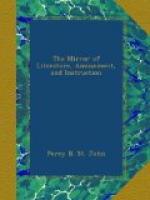[11] Jennings Ornithologia, p. 199, note. [12] Ornith. Dict. Art. Heron. [13] J.R. [14] Belon, Oiseaux, p. 189
At the close of the volume are a few well-digested observations, which will leave the reader in a delightful train of reflection, impress him with the value of the preceding pages, and enable him to close the volume with gratitude to its author:—
“Although, in the preceding pages, we have considered birds as miners, as ground-builders, as masons, as carpenters, as platform-builders, as basket-makers, as weavers, as tailors, as felt-makers, as cementers, and as dome-builders, we have not dwelt at much length upon any fancied analogies between their arts and those of the human race. The great distinction between man and the inferior animals is, that the one learns almost every art progressively, by his own experience operating with the accumulated knowledge of past generations, whilst the others work by a fixed rule, improving very little, if any, during the course of their own lives, and rarely deviating to-day from the plans pursued by the same species a thousand years ago. It is true that the swallow, which doubtless once built its nest in hollow trees, has now accommodated itself to the progress of human society by choosing chimneys for nestling; and it is also to be noticed, that in the selection of materials a great many birds, as we have already shown, accommodate themselves to their individual opportunities of procuring substances differing in some degree from those used in other situations by the same species. These adaptations only show that the instinct which guides them to the construction of the nests best fitted to their habits is not a blind one; that it is very nearly allied to the reasoning faculty, if it is not identified with it. But that the rule by which birds conduct their architectural labours is exceedingly limited must be evident, from the consideration that no species whatever is in a state of progression from a rude to a polished style of construction. There is nearly as much difference between the comparative beauty




